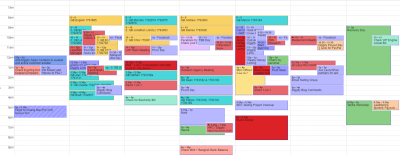I think we can all agree here…
Managing time is extremely difficult in the SEO world.
So many projects, clients, affiliate sites… but not enough time to deal with them.
I’m a busy guy.
46 live money sites, 4630 PBNs, and three companies does that to a person.
The only possible way I can stay efficient and continue to grow my businesses is through strategic and systematized time management.
In this article, I’ll be deviating from my normal topic focus about SEO ranking techniques, case studies and test results.
Instead I will be teaching, what I believe to be, the most powerful SEO technique period: the ability to carefully manage time. Smart time management allows you to work on more projects, get more clients, build more sites, and test more ranking techniques.
What you’re going to be learning is the exact process I’ve developed over the years which will enable you to:
- See exactly where your time is being spent
- Determine which are your highest $/hour projects
- Find out which are your biggest time sinks
- Figure out your Personal Value per Hour (PVH)
- Offload all tasks that can be outsourced for less than your value per hour
By the end of this post, you’ll have a solid framework that you can duplicate to see where the biggest time-wasters exist in your life so you can eradicate them in the name of massive productivity.
Background
By all means, I am no pioneer in the areas of time management and personal efficiency. However, I am a big book nerd (see my recommended reading list) and I know where to look for answers.
I was first introduced to the allure of time management from the oh-so-famous 4-Hour Work Week. This modern classic for today’s digital nomad opened my eyes to the importance of time efficiency.
Back in 2010, I was an engineer for a software company… or should I say “slave”?
On a typical week, I spent 60+ hours doing inefficient work that was used to sell software using an archaic sales process, while hoping to make people rich… people that weren’t me.

Once I broke free of the 9-5 and went full time into the SEO industry, I knew I wanted to do things differently. I was scorned by the inefficiencies of old school corporate work culture, and wanted to **** my own processes for productivity.
At that point, I sat down and hit the books.
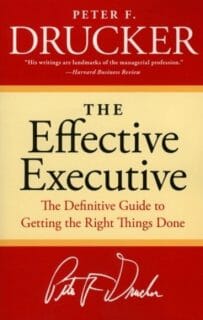 The book that has had the biggest impact with regards to time management is Peter Drucker’s Effective Executive. In this book, Drucker has an entire chapter on the importance of managing your time.
The book that has had the biggest impact with regards to time management is Peter Drucker’s Effective Executive. In this book, Drucker has an entire chapter on the importance of managing your time.
I selected the key essentials from this book (and others) and came up with a system that enables me to accurately see where my time is going, so I can invest more into the areas that are generating me money and happiness, while surgically removing time-wasters.
Through a few years of trial and error, I’ve perfected the simple but effective process you’re about to learn.
The Quarterly Time-Management Audit
Every 3 months, I sit down and begin the following process.
It takes two weeks to complete, but adds only about 1% to your workload during this time.
By the end of it you’ll be able to see exactly how much time you’re spending in efficient activities, how much time is being wasted, and what you can do to optimize.
Before you begin this endeavor, note that…
Integrity is the key to making this work. You MUST be consistent.
Make a promise to yourself to stick to it every day.
Phase 1 – Day 1 to Day 14: Track Each Minute of Your Working Day
The purpose of this phase is to track down exactly where your time is going so that you can audit it later using a simple spreadsheet that I’ll soon be providing you.
The ***** before you start this process, get a piece of paper and a pen lay them down on top of your keyboard.
Get a good *****’s sleep and wake up the next day, bright and early, ready for work.
From the second you sit down and the computer and start working, you’re going to write down how each minute is spent.
- Write down your first task
- Write down the minute you started doing it
- Write down the minute you stopped doing it
Typically, I wake up, brush my teeth, meditate and grab some food. Then the first work-related task I do is on Facebook: replying to tags, answering questions, etc.
My first entry typically looks like this:

Then I jump on email. I like to make sure that each person depends on me for answers has what they need to continue on with their tasks. I’ll record this down as well:
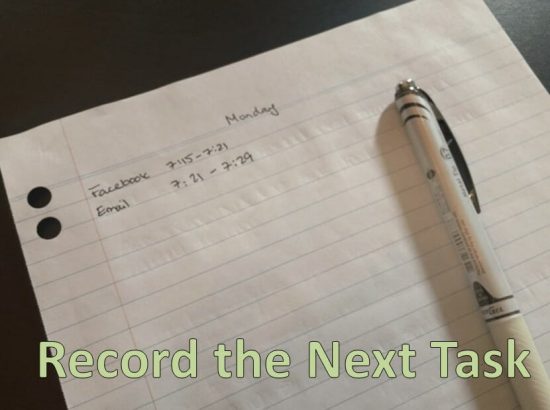
As the day goes on, whenever you start a new task, it gets added to your notes. In the event that you go back to doing a task a second time (such as below with email), make sure to tack that onto sheet.
Note how there are two time entries for “Email” as I’ve worked on email twice so far:
![]()
Easy stuff.
By the end of the day, you’ll have a sheet that looks like this:
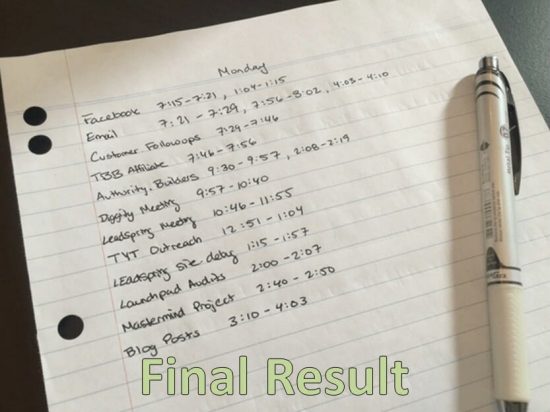
Call it a day and tuck away your notes for phase 2 of this exercise.
Come tomorrow morning, you’re going to wake up and do the same thing. In fact, you’re going to continue this forward for a full 14 days, before you move on to phase 2.
Expect to Start Seeing Benefits Already
As you go through this phase of tracking your activity, you’ll begin to experience some intense benefits.
For one, you’re going to be working more efficiently. When you’re on email-duty, for example, since you’re tracking time, you’ll work faster.
Why?
Because your ego doesn’t want you to write down 65 minutes instead of 15 for doing a task because you got distracted watching fail compilations on YouTube.
You’re going to stay focused because you want to write down a small number. You want to prove to yourself that you’re fast.
The ego is your friend, in this case.
You’ll also notice that you’re batching together your activities more. When it’s time to do client follow-ups, you’ll naturally want to do them all in a row.
Since you know you have to track time every time you switch between activities, it makes more sense to simply so all your client follow-ups in one session, rather than toggle between that and email and placing backlinks, etc.
Batching is hands-down, one of the best tools in your arsenal to work more efficiently.
We’ll visit this again later after we audit your time expenditure.
Frequently Asked Questions so Far
Q: Why use pen and paper? Aren’t there apps for this?
A: In my experience, the tactile requirement of actually picking up a piece of pen and repeatedly tracking your tasks on paper instills a muscle memory and makes the task hard to forget.
While an app is supposed to automate the process, you still need to remember to turn it on. And let me just tell you now; if the app crashes and loses your data after 13 days, you’re probably going to murder someone.
Q: Why do we do this for two weeks?
A: Most likely, each of your weeks varies from one to the next. One week you might be working intensely on closing clients, and the next you might be working on your own affiliate projects.
By tracking two weeks, we’re capturing a larger sample of your life, and we’ll be taking the average of each of the weeks.
Phase 2 – The Audit of all Audits
Once you’ve gathered two weeks of data, it’s time to start entering it into a master spreadsheet.
This spreadsheet is designed to do two main things:
- Lay out exactly where you’re spending your time
- Find out how much time you’re spending in rewarding projects vs. non-rewarding projects
Let’s see how it works.
Fill in the Time Analysis Spreadsheet
For each day of the week that you’ve tracked, simply add in the total number of minutes that you spent on each task.
Here’s what my sheet looks like after entering the first Sunday and Monday of the time tracking phase.
In dark blue, you’ll see my main businesses (or projects) which are broken down into smaller tasks.

Continue to fill out each day of the week.
Once you’re done, you’ll be over to scroll over to the right-hand side and see exactly how many hours you spend in each task as well as each project they’re associated with.
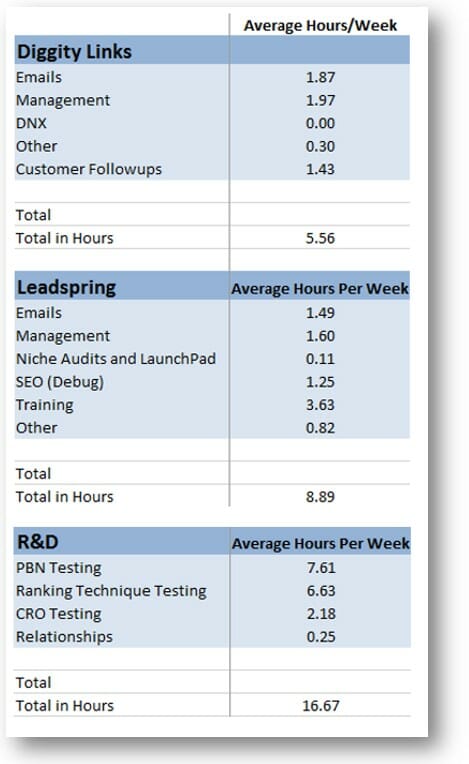
Record How Much Money You Made in the Previous Month
Now here’s the fun part.
Notice the yellow squares. Here’s where you fill out how much money each of your businesses/projects/clients made for you in the previous month.
(Note: I’m not using real numbers in this example because I’m not an “income report kind of guy”.)
The tool will then calculate exactly how much money per hour you make from each project.
Already we can make some incredible insights.
As you probably know, I’m an affiliate SEO but I do personally take care of a couple of clients outside of my agency The Search Initiative. Check out the data I just pulled up on these two clients.

The client “FTF” on top is your typical dream client: low maintenance and easy to rank. Because everything is automated (even the monthly reporting) I spend on average 0.18 hours a week on the project (10.8 minutes per week) and take in $1000/month. This results in a earning of $1253.92/hour.
On the other hand, client “TYT” has a few more issues. I’m spending 1.88 hours per week on this project, while also earning $1000/month. But the value per time is much lower: $122.61/hour.
It becomes easy to see where I should be focused. Clients like FTF fit the ideal profile and it would be in my best interest to seek out other clients that fit the bill.
It’s also easy to see where I need to do some optimizing.
Now compare this to the time efficiency of JV affiliate sites:

As you already know, once affiliate sites are ranking #1 they require very little effort but can pay off quite considerably.
Sites like PCUI generate $27,586.21 per hour!
This is essentially why I like JV’s so much and hence why I created LeadSpring.
See how I go through my entire business and see where the short comings are and where the big winners lie…
Ready to get started?
Download the Time Tracking Spreadsheet Now
The Final Analysis
Once you have everything laid all out in front of you, it’s time to fully analyze this data to get a real snapshot on where you’re actually spending your time.
Here’s a list of the main things you should look at:
1) How many exact hours per week do you work?
Because you’re tracking exactly how many minutes you’re actually working, as opposed to how much time we’re simply sitting at the computer (there’s a big difference), we can see our inefficiencies.
 After this analysis, I can see that I work (on average) 47.06 hours week.
After this analysis, I can see that I work (on average) 47.06 hours week.
The first question I ask myself is: does this make sense?
Was I actually sitting in the office for 50 hours this week, but really only worked 47.06 hours?
What else was I doing this whole time?
If there’s a big discrepancy, you need to take a long hard look at where your time-wasters lie.
2) What are your biggest time sinks?
Figure out which projects, businesses, affiliate sites, and clients are your biggest time sinks. Unless they have a high profit/hour ratio or they give you pleasure in doing them (also very important), give them the axe.
3) What are your most efficient profit makers?
Rank each project, business, affiliate site and client by their profit/hour.
Look at the ones that are very time efficient. Do more of them.
Look at the ones that have low time efficiency. Outsource them (more on this soon).
Phase 3) Optimize your Time
As you can see, the process is actually very simple.
As long as you track your time and profits accurately, you can make quantitative, data-based decisions about your business, rather than using your intuition which is often wrong.
So now that you know exactly where your time is being wasted, what do you do with those low value, time sinks?
Outsource the Time Wasters
You might have noticed; this spreadsheet helps you calculate your Personal Value per Hour (PVH).

Look at all your projects that have low profit/hour and if you can outsource them for less than your PVH, then you actually make money.
This applies both to business tasks and also personal tasks.
If your value/hour is $300 and it costs you $50 for someone to mow the lawn, why are you still doing it yourself? Unless you get immense pleasure from creating lovely green rows of grass, outsource it and use that time to work on your business or the activities you ****.
Leverage What You Learned from The Exercise Itself
When you were time tracking, I guarantee you were being very efficient with your time.
You weren’t jumping between tasks and you likely weren’t watching cat videos when you knew you were on the clock for tracking how long it took to perform a client audit.
Take these practices and make them habits.
Stay focused when you’re on certain tasks.
Batch your tasks together. When it’s time for cold emails, do them all at once.
After a certain amount of time in a task, you being to hit a flow state, where everything becomes easier and faster. Once you’re in a flow state, it becomes very difficult to get back into it once you’ve derailed yourself. Experts say it takes 25 minutes fully get back into a flow state (read more).
I’ve taught this time tracking process to others and many have adopted this as a full-time activity.
Some people, myself included, enjoy the efficiency of being under-watch.
Conclusion
This blog post, including the videos, took 2 hours and 37 minutes to create, film, and post on my blog.
Does it have high profit per time? Not really.
Nonetheless, I **** writing articles for my blog, and I definitely won’t ever outsource any of it.
I hope you enjoyed this article as much as I did writing it.
And I hope you can leverage what I’ve shared here to take some massive action on improving your time efficiency.

